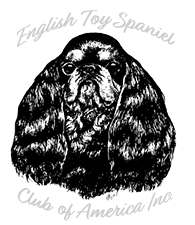Charles II was famous then, as now, as a pleasure seeker, and his nation enjoyed a renaissance in the arts and sciences during his reign. The Puritanical regulations against drinking, dancing, the theatre, scientific research and even against colorful clothing were stricken from the laws or otherwise not enforced. Charles II is often referred to as the “Merry Monarch”. The king’s devotion to his dogs is the historical connection which gave the breed the name King Charles Spaniel. His mother, Queen Henrietta Maria [daughter of the French King Henri IV and Marie de Medici] had arrived in England with several of her small pet French or “Continental” spaniels. Known in England as “Queen Mary”, Lord Baltimore named the colony he founded in America “Maryland” after Queen Henrietta Maria.
Charles I was fond of his wife’s dogs, and these were obviously interbred with the small pet dogs and spaniels already in England. The ‘Epagnielles Royale’ [variously spelled] were observed at court during his reign as well as the reign of his son Charles II, who by Royal Proclamation granted the spaniels unrestricted access throughout his domain. Charles II was criticized for being distracted from cabinet meetings and other affairs of government by the presence of his playful pet dogs. Even the great Royalist supporter and important diarist of the period Samuel Pepys shook his head in disapproval. An unidentified courtier once reportedly quipped: “God Save His Majesty, but God damn his dogs.” Samuel Pepys was an English naval administrator and Member of Parliament [lived 1633-1703]. His eyewitness accounts recorded in his diaries about King Charles II, the Great Plague [started as early as April 1665] and of the Great Fire of London [September 2-5, 1666] are fascinating and very personal.
THE MODERN ERA
Except in the United States and Canada, to this day the breed is still known in all other nations as the King Charles Spaniel and must
not be confused with its cousin, the relatively modern, more recently re-developed Cavalier King Charles Spaniel, recognized by the AKC in 1995. Remember that the revival of the Cavalier King Charles Spaniel as a separate toy breed did not begin in earnest until the latter part of the 1920s, when breeders in Britain competed for prize money offered from 1926 for 5 consecutive years at Crufts Dog Show by Mr. Roswell Eldridge, an American who wished to encourage a revival of the vanished type of small spaniels we know today as the Cavalier King Charles Spaniel. An overwhelming success, most certainly this process involved outcrosses of the King Charles Spaniel to the drop-eared Papillon, known as the Phalene, and possibly crossbreeding with other small hunting or Cocker spaniels.
Although small in number, with only the Affenpinscher being a rarer AKC Toy breed, today the English Toy Spaniel is beloved by average citizens and quite adaptable to most any modern-era living arrangements, town or country. American fanciers remain united under the stewardship of the English Toy Spaniel Club of America and by an unmovable dedication to the preservation and protection of this delightful, truly historic breed. Membership is a special privilege which requires adherence to an enforceable “Code of Ethics”, under penalty of suspension or permanent expulsion from the club. With continued advances in genetic research, attempting to identify and therefore possibly eliminate various recurring canine health issues, the future looks very promising. Let us work diligently to give to future generations a unique purebred dog worthy of its place in history and in our hearts.
